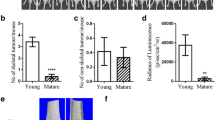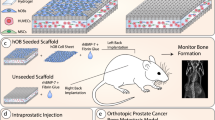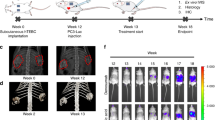Abstract
Spontaneous development of osteoblastic lesions of prostate cancer (PCa) in mice is modeled by orthotopic (intraprostatic) deposition of neoplastic cells followed by an extremely long latency associated with low incidence of spontaneous bone metastasis. Intracardial injection results in overt bone metastases only with osteoclastic PCa cells (i.e., PC-3). Herein, we report that androgen independent osteoblastic PCa cells readily colonize bone when in a high remodeling state. SCID/Beige mice were subjected to periods of intermittent human parathyroid hormone 1–34 (hPTH) exposure, followed by an intracardiac infusion of osteoblastic C4-2 PCa cells. At the time of PCa infusion, analysis of bone turnover markers from mice treated with hPTH revealed significant increases in osteocalcin (55.06 ± 7.5 vs. 74.01 ± 18.5 ng/ml) and TRAcP-5b (3.3 ± 0.6 vs. 4.81 ± 0.8 U/l), but no change in type I collagen C-terminal teleopeptide levels relative to control mice. Analysis of femoral cancellous bone architecture revealed significant increases in bone mineral density, trabecular thickness (0.056 ± 0.002 vs. 0.062 ± 0.001 mm) and porosity, but significant decreases in connectivity density and trabecular number in hPTH treated mice relative to controls. By 8 weeks post-infusion, 70% of mice pre-treated with hPTH demonstrated detectable serum prostate specific antigen (PSAs) ranging between 2 and 18.8 ng/ml. Immuno-histochemical labeling of femurs for PSA and pan-Cytokeratin revealed the presence of significant tumor cell nests in marrow and trabecular spaces. These results suggest that: (1) local bone physiology is an important factor for developing osteoblastic/sclerotic PCa bone metastases in murine hosts; (2) the establishment of osteosclerotic PCa bone metastases in mice is enhanced by alterations that drive bone formation.








Similar content being viewed by others
Abbreviations
- PCa:
-
Prostate cancer
- PSA:
-
Prostate specific antigen
- hPTH:
-
Human parathyroid hormone fragment 1–34
- BMD:
-
Bone mineral density
- BV:
-
Bone volume
- TV:
-
Total volume
- BV/TV:
-
Bone volume fraction
- Tb.N:
-
Trabecular number
- Tb.Th:
-
Trabecular thickness
- Tb.Sp:
-
Trabecular separation
- SMI:
-
Structural model index
References
Jemal A, Siegel R, Ward E et al (2008) Cancer statistics, 2008. CA Cancer J Clin 58(2):71–96. doi:10.3322/CA.2007.0010
Saitoh H, Hida M, Shimbo T et al (1984) Metastatic patterns of prostatic cancer. Correlation between sites and number of organs involved. Cancer 54(12):3078–3084. doi:10.1002/1097-0142(19841215)54:12<3078::AID-CNCR2820541245>3.0.CO;2-U
Jacobs SC (1983) Spread of prostatic cancer to bone. Urology 21(4):337–344. doi:10.1016/0090-4295(83)90147-4
Koutsilieris M (1995) Skeletal metastases in advanced prostate cancer: cell biology and therapy. Crit Rev Oncol Hematol 18(1):51–64. doi:10.1016/1040-8428(94)00122-A
Koutsilieris M, Tolis G (1985) Long-term follow-up of patients with advanced prostatic carcinoma treated with either buserelin (HOE 766) or orchiectomy: classification of variables associated with disease outcome. Prostate 7(1):31–39. doi:10.1002/pros.2990070105
Batson OV (1967) The vertebral system of veins as a means for cancer dissemination. Prog Clin Cancer 3:1–18
Batson OV (1995) The function of the vertebral veins and their role in the spread of metastases, 1940. Clin Orthop Relat Res (312):4–9
Ghossein RA, Scher HI, Gerald WL et al (1995) Detection of circulating tumor cells in patients with localized and metastatic prostatic carcinoma: clinical implications. J Clin Oncol 13(5):1195–1200
Theodorescu D, Frierson HF Jr, Sikes RA (1999) Molecular determination of surgical margins using fossa biopsies at radical prostatectomy. J Urol 161(5):1442–1448. doi:10.1016/S0022-5347(05)68919-7
Killion JJ, Fidler IJ (1989) Mechanisms of cancer metastasis. Arzneimittelforschung 39(8A):1031–1034
Koeneman KS, Yeung F, Chung LW (1999) Osteomimetic properties of prostate cancer cells: a hypothesis supporting the predilection of prostate cancer metastasis and growth in the bone environment. Prostate 39(4):246–261. doi:10.1002/(SICI)1097-0045(19990601)39:4<246::AID-PROS5>3.0.CO;2-U
Thalmann GN, Sikes RA, Wu TT et al (2000) LNCaP progression model of human prostate cancer: androgen-independence and osseous metastasis. Prostate 44(2):91–103 1;44(2)
Soos G, Jones RF, Haas GP et al (1997) Comparative intraosseal growth of human prostate cancer cell lines LNCaP and PC-3 in the nude mouse. Anticancer Res 17(6D):4253–4258
Fisher JL, Schmitt JF, Howard ML et al (2002) An in vivo model of prostate carcinoma growth and invasion in bone. Cell Tissue Res 307(3):337–345. doi:10.1007/s00441-001-0503-x
Rosol TJ, Tannehill-Gregg SH, LeRoy BE et al (2003) Animal models of bone metastasis. Cancer 97(Suppl 3):748–757. doi:10.1002/cncr.11150
Schneider A, Kalikin LM, Mattos AC et al (2005) Bone turnover mediates preferential localization of prostate cancer in the skeleton. Endocrinology 146(4):1727–1736. doi:10.1210/en.2004-1211
Iida-Klein A, Zhou H, Lu SS et al (2002) Anabolic action of parathyroid hormone is skeletal site specific at the tissue and cellular levels in mice. J Bone Miner Res 17(5):808–816. doi:10.1359/jbmr.2002.17.5.808
Wu TT, Sikes RA, Cui Q et al (1998) Establishing human prostate cancer cell xenografts in bone: induction of osteoblastic reaction by prostate-specific antigen-producing tumors in athymic and SCID/bg mice using LNCaP and lineage-derived metastatic sublines. Int J Cancer 77(6):887–894. doi:10.1002/(SICI)1097-0215(19980911)77:6<887::AID-IJC15>3.0.CO;2-Z
Parfitt AM, Drezner MK, Glorieux FH et al (1987) Bone histomorphometry: standardization of nomenclature, symbols, and units. Report of the ASBMR Histomorphometry Nomenclature Committee. J Bone Miner Res 2(6):595–610
Yoshiki S, Umeda T, Kurahashi Y (1972) An effective reactivation of alkaline phosphatase in hard tissues completely decalcified for light and electron microscopy. Histochem Cell Biol 29(4):296–304
Miao D, Scutt A (2002) Histochemical localization of alkaline phosphatase activity in decalcified bone and cartilage. J Histochem Cytochem 50(3):333–340
Sawyer A, Lott P, Titrud J et al (2003) Quantification of tartrate resistant acid phosphatase distribution in mouse tibiae using image analysis. Biotech Histochem 78(5):271–278. doi:10.1080/10520290310001646668
Degraff DJ, Malik M, Chen Q et al (2007) Hormonal regulation of IGFBP-2 proteolysis is attenuated with progression to androgen insensitivity in the LNCaP progression model. J Cell Physiol 213(1):261–268. doi:10.1002/jcp.21123
Degeorges A, Wang F, Frierson HF Jr et al (2000) Distribution of IGFBP-rP1 in normal human tissues. J Histochem Cytochem 48(6):747–754
Yang WD, Gomes RR Jr, Alicknavitch M et al (2005) Perlecan domain I promotes fibroblast growth factor 2 delivery in collagen I fibril scaffolds. Tissue Eng 11(1–2):76–89. doi:10.1089/ten.2005.11.76
Lindsay R, Nieves J, Formica C et al (1997) Randomised controlled study of effect of parathyroid hormone on vertebral-bone mass and fracture incidence among postmenopausal women on oestrogen with osteoporosis. Lancet 350(9077):550–555. doi:10.1016/S0140-6736(97)02342-8
Zhou H, Iida-Klein A, Lu SS et al (2003) Anabolic action of parathyroid hormone on cortical and cancellous bone differs between axial and appendicular skeletal sites in mice. Bone 32(5):513–520. doi:10.1016/S8756-3282(03)00057-7
Leaffer D, Sweeney M, Kellerman LA et al (1995) Modulation of osteogenic cell ultrastructure by RS-23581, an analog of human parathyroid hormone (PTH)-related peptide-(1–34), and bovine PTH-(1–34). Endocrinology 136(8):3624–3631. doi:10.1210/en.136.8.3624
Podbesek R, Edouard C, Meunier PJ et al (1983) Effects of two treatment regimes with synthetic human parathyroid hormone fragment on bone formation and the tissue balance of trabecular bone in greyhounds. Endocrinology 112(3):1000–1006
Hock JM, Gera I (1992) Effects of continuous and intermittent administration and inhibition of resorption on the anabolic response of bone to parathyroid hormone. J Bone Miner Res 7(1):65–72
Iida-Klein A, Hughes C, Lu SS et al (2006) Effects of cyclic versus daily hPTH(1–34) regimens on bone strength in association with BMD, biochemical markers, and bone structure in mice. J Bone Miner Res 21(2):274–282. doi:10.1359/JBMR.051017
Frolik CA, Black EC, Cain RL et al (2003) Anabolic and catabolic bone effects of human parathyroid hormone (1–34) are predicted by duration of hormone exposure. Bone 33(3):372–379. doi:10.1016/S8756-3282(03)00202-3
Bellido T, Ali AA, Gubrij I et al (2005) Chronic elevation of parathyroid hormone in mice reduces expression of sclerostin by osteocytes: a novel mechanism for hormonal control of osteoblastogenesis. Endocrinology 146(11):4577–4583. doi:10.1210/en.2005-0239
Lindsay R, Nieves J, Henneman E et al (1993) Subcutaneous administration of the amino-terminal fragment of human parathyroid hormone-(1–34): kinetics and biochemical response in estrogenized osteoporotic patients. J Clin Endocrinol Metab 77(6):1535–1539. doi:10.1210/jc.77.6.1535
Hurley MM, Tetradis S, Huang YF et al (1999) Parathyroid hormone regulates the expression of fibroblast growth factor-2 mRNA and fibroblast growth factor receptor mRNA in osteoblastic cells. J Bone Miner Res 14(5):776–783. doi:10.1359/jbmr.1999.14.5.776
Qin L, Qiu P, Wang L et al (2003) Gene expression profiles and transcription factors involved in parathyroid hormone signaling in osteoblasts revealed by microarray and bioinformatics. J Biol Chem 278(22):19723–19731. doi:10.1074/jbc.M212226200
McClelland P, Onyia JE, Miles RR et al (1998) Intermittent administration of parathyroid hormone (1–34) stimulates matrix metalloproteinase-9 (MMP-9) expression in rat long bone. J Cell Biochem 70(3):391–401. doi:10.1002/(SICI)1097-4644(19980901)70:3<391::AID-JCB12>3.0.CO;2-O
Miles RR, Sluka JP, Halladay DL et al (2000) ADAMTS-1: a cellular disintegrin and metalloprotease with thrombospondin motifs is a target for parathyroid hormone in bone. Endocrinology 141(12):4533–4542. doi:10.1210/en.141.12.4533
Togari A, Shintani S, Arai M et al (1990) Acute effect of parathyroid hormone-(1–34) fragment on blood pressure in rats fed a low calcium diet. Gen Pharmacol 21(4):547–549. doi:10.1016/0306-3623(90)90712-U
Imbriaco M, Larson SM, Yeung HW et al (1998) A new parameter for measuring metastatic bone involvement by prostate cancer: the Bone Scan Index. Clin Cancer Res 4(7):1765–1772
Clarke NW, McClure J, George NJ (1993) Osteoblast function and osteomalacia in metastatic prostate cancer. Eur Urol 24(2):286–290
De Bruyn PP (1981) Structural substrates of bone marrow function. Semin Hematol 18(3):179–193
Kalikin LM, Schneider A, Thakur MA et al (2003) In vivo visualization of metastatic prostate cancer and quantitation of disease progression in immunocompromised mice. Cancer Biol Ther 2(6):656–660
Rico H, Uson A, Hernandez ER et al (1990) Hyperparathyroidism in metastases of prostatic carcinoma: a biochemical, hormonal and histomorphometric study. Eur Urol 17(1):35–39
Berruti A, Dogliotti L, Gorzegno G et al (1999) Differential patterns of bone turnover in relation to bone pain and disease extent in bone in cancer patients with skeletal metastases. Clin Chem 45(8 Pt 1):1240–1247
Buchs N, Bonjour JP, Rizzoli R (1998) Renal tubular reabsorption of phosphate is positively related to the extent of bone metastatic load in patients with prostate cancer. J Clin Endocrinol Metab 83(5):1535–1541. doi:10.1210/jc.83.5.1535
Murray RM, Grill V, Crinis N et al (2001) Hypocalcemic and normocalcemic hyperparathyroidism in patients with advanced prostatic cancer. J Clin Endocrinol Metab 86(9):4133–4138. doi:10.1210/jc.86.9.4133
Schwartz GG (2008) Prostate cancer, serum parathyroid hormone, and the progression of skeletal metastases. Cancer Epidemiol Biomarkers Prev 17(3):478–483. doi:10.1158/1055-9965.EPI-07-2747
Acknowledgments
We thank high school student Dyanna González for her assistance with the immunohistochemistry, and Dr. Arivalanagan Muthusamy, Sarah Sheehan, and members of the Division of Musculoskeletal Sciences for helpful discussions and critical reading of the manuscript, and Ananya Das for secretarial assistance.
Grant support
Dean’s Feasibility Grant from the Penn State College of Medicine, and the Pennsylvania Department of Health using Tobacco Settlement Funds (to R.R.G.). The Department specifically disclaims responsibility for any analyses, interpretations or conclusions. Support was also provided from NIH INBRE P20RR016472, DoD PCRP PC073886 (R.A.S. and K.L.V.G)
Author information
Authors and Affiliations
Corresponding author
Rights and permissions
About this article
Cite this article
Gomes, R.R., Buttke, P., Paul, E.M. et al. Osteosclerotic prostate cancer metastasis to murine bone are enhanced with increased bone formation. Clin Exp Metastasis 26, 641–651 (2009). https://doi.org/10.1007/s10585-009-9263-x
Received:
Accepted:
Published:
Issue Date:
DOI: https://doi.org/10.1007/s10585-009-9263-x




